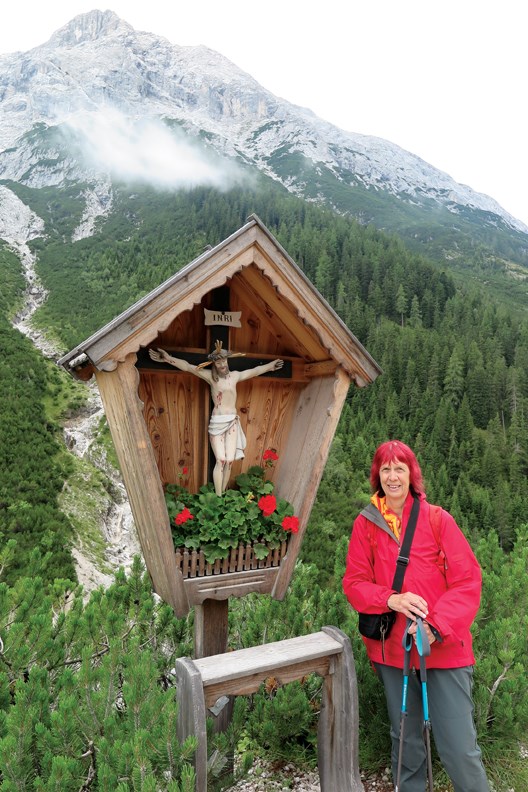If you love alpine views but prefer flatter terrain for walking, the Austrian Seefeld Plateau of the Leutasch Valley is for you. Famous for cross-country skiing in winter, this area of the central Tyrol features over 650 kilometres of hiking trails and 60 alms and huts for rest and refreshment. My base for exploring this area was the Kristall Hotel in Weidach, one of the 24 hamlets of the Leutasch.
The difference between an alm and a hut is that an alm is part of the system of vertical transhumance, whereby each year in Tyrol, 180,000 horses, sheep, steers and goats spend over 90 days of the summer in over 2,600 alpine pastures. The cows are milked twice daily, and cheese is made. The alms may also have alpine huts that offer food, and sometimes lodging. In addition, special-purpose huts were built, originally by hiking associations, to provide mountain refuges and accommodation. The German word Alp (a variation of Alm) is originally identical to the name of the Alps (Alpen). As part of a 400-year old tradition, the driving home of the animals in the fall, the Almabtrieb or Almhoamfahr’n, is celebrated and the cows are even decorated. Hiking the Seefeld Plateau, I stopped at as many as three alms in one day, and enjoyed sitting on a long outside bench against the wall under an overhang for shelter from rain and sun, at a table facing the pastures and the animals, and gazing at the mountains. The long bench provided the chance to chat with other hikers; the wine, beer or Almdudler (a sweetened carbonated drink made of herbal extracts) encouraged cordiality; and a goulash, schnitzel, Spätzle (pasta, onion and cheese dish), or Kaiserschmarrn, made up of pancake strips and fruit, such as plums or berries, fortified me for the next leg of the hike. As you can imagine, I grew to find the alms and huts as essential to my hiking as my walking poles.
The village inn or the Wirtshaus is also an important Tyrolean tradition that goes back to Roman travellers and to the Middle Ages when travellers found refuge in the hospices of the churches and monasteries. As the number of traders, travelling apprentices, and pilgrims increased, many parsonages also served as inns. As you eat your Tiroler Speckbrett, a board of ham slices with vegetables and cheese, washed down with a measure of Austrian beer, you can be part of this tradition.
One of the best hikes of my week of guided hikes was part of a new tradition, having been available only since 2006, the year of completion of a 1.4 million Euro Austro-German project to build steel walkways and pedestrian bridges over the Spirit Gorge, the longest accessible gorge in the Eastern Limestone Alps. The Spirit Gorge is a 75-metre deep chasm of the Leutascher Ache, the same placid river I had hiked along for most of the week, now turned into churning eddies and whirlpools.
On the other side of the gorge, I walked into Germany and on to Mittenwald, where I toured the violin museum with its displays of not only what was made and how, but who made the instruments, including true accounts of the hard lives of the women and men who did the piece work in their houses, which were often dark, damp and cold. Finally, the Gaistal, a hanging Alpine valley known as the Almen Paradise. We followed the Ludwig Ganghofer Trail, named after the bestselling German writer, who was famous for his stories of the mountains and the films based on them, and who had a hunting lodge in the area. The steep rocky hillsides were covered in coniferous forests and open pasture land, and I heeded the warning to stay on the trail and not disturb the grazing animals. Near a mountain stream was an area dedicated to Sebastian Kneipp, the Bavarian priest who developed his water cures when he was ill with tuberculosis. His clients included Archduke Franz Ferdinand of Austria as well as Pope Leo XIII, and his method was based upon brief applications of cold water to cause the blood vessels to narrow and then contract. He also advocated relaxation and stimulation, and the site featured a comfortable wooden lounge as well as textured walking paths for the bare-footed.
I booked my airfares through a travel agency here and the guided hiking was with HF Holidays, a cooperative.



